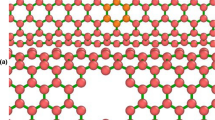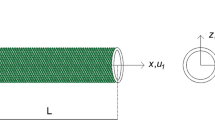Abstract
Free vibration response of the single-walled carbon nanotubes (SWCNTs) is investigated using molecular dynamics simulation. Vibrational analysis is performed to study the effects of various defect parameters such as aspect ratio, chirality, presence of vacancy defects, numbers of defects and their position along the length of the SWCNT. The effects of these features on the natural vibration of SWCNTs are studied by determining the change in fundamental natural frequencies due to these features. Dynamics simulations are performed for cantilever boundary condition. Vibrational response obtained through molecular dynamic simulations indicates that shorter tubes offer higher vibrational sensitivity. Chirality effect is found to diminish with the increase in the length of tube. It is also found that the number of defects and their position along the tube affect greatly the natural frequency of the SWCNT. This study will provide invaluable input to the designers and users of carbon nanotube in the field of high-sensitive sensor application.








Similar content being viewed by others
References
M.F. Yu, O. Lourie, M.J. Dyer, K. Moloni, T.F. Kelly, R.S. Ruoff, Strength and breaking mechanism of multiwalled carbon nanotubes under tensile load. Science 287(5453), 637–640 (2000)
M. Goel, S.P. Harsha, M.P. Mishra, R.K. Mishra, Buckling failure analysis of defective carbon nanotubes using molecular dynamics simulation. J. Fail. Anal. Prev. (2020). https://doi.org/10.1007/s11668-020-00886-x
M. Goel, S.P. Harsha, S. Singh, A.K. Sahani, Analysis of temperature, helicity and size effect on the mechanical properties of carbon nanotubes using molecular dynamics simulation. Mater. Today Proc. (2020). https://doi.org/10.1016/j.matpr.2020.01.130
M.M.J. Treacy, T.W. Ebbesen, J.M. Gibson, Exceptionally high Young’s modulus observed for individual carbon nanotubes. Nature 381, 678–680 (1996)
Q. Zhao, Z.H. Gan, O.K. Zhuang, Electrochemical sensors based on carbon nanotubes. Electroanalysis 14, 1609–1613 (2002)
X.M.H. Huang, X.L. Feng, C.A. Zorman, M. Mehregany, M.L. Roukes, VHF, UHF and microwave frequency nanomechanical resonators. New J. Phys. 7, 247 (2005)
K. Jensen, K. Kim, A. Zett, An atomic-resolution nano-mechanical mass sensor. Nat. Nanotechnol. 3, 533–537 (2008)
Q. Wang, Atomic transportation via carbon nanotubes. Nano Lett. 9, 245 (2009)
T. Thundat, P.I. Oden, R.J. Warmack, Microcantilever sensors. Microscale Thermophys. Eng. 1, 185–199 (1997)
P. Hauptmann, R. Lucklum, A. Püttmer, B. Henning, Ultrasonic sensors for process monitoring and chemical analysis: state-of-the-art and trends. Sens. Actuat. A Phys. 67(1–3), 32–48 (1998)
B. Ilic, D. Czaplewski, H.G. Craighead, Mechanical resonant immune specific biological detector. Appl. Phys. Lett. 77, 450 (2000)
P. Poncharal, Z.L. Wang, D. Ugarte, W.A. de Heer, Electrostatic deflections and electromechanical resonances of carbon nanotubes. Science 283(5407), 1513–1516 (1999)
Nickolay V. Lavrik, Panos G. Datskos, Femtogram mass detection using photothermally actuated nanomechanical resonators. Appl. Phys. Lett. 82, 2697 (2003)
B. Ilic, H.G. Craighead, S. Krylov, W. Senaratne, C. Ober, P. Neuzil, Attogram detection using nano-electromechanical oscillators. J. Appl. Phys. 95, 3694–3703 (2004)
A.Y. Joshi, S.C. Sharma, S.P. Harsha, Effect of chirality and atomic vacancies on dynamics of nano resonators based on SWCNT. Sens. Rev. 31(1), 47–57 (2011)
A.Y. Joshi, S.C. Sharma, S.P. Harsha, The effect of pinhole defect on vibrational characteristics of single walled carbon nanotube. Phys. E: Low-Dimens. Syst. Nanostruct. 43(5), 1040–1045 (2011)
A. Ghavamian, A. Ochsner, Numerical modeling of Eigen-modes and Eigen-frequencies of Singleand multi-walled carbon nanotubes under the influence of atomic defects. Comput. Mater. Sci. 72, 42–48 (2013)
L.J. Chen, Q. Zhao, Z. Gong, The effects of different defects on vibration properties of single-walled carbon nanotubes. Adv. Mater. Res. 225–226, 1133–1136 (2011)
S.K. Georgantzinos, G.I. Giannopoulos, N.K. Anifantis, The effect of atom vacancy defect on the vibrational behavior of single-walled carbon nanotubes. A structural mechanics approach. Adv. Mech. Eng. 6, 291645 (2014)
S.J. Stuart, A.B. Tutein, J.A. Harrison, A reactive potential for hydrocarbons with intermolecular interactions. J. Chem. Phys. 112, 6472–6486 (2000)
W.G. Hoover, Canonical dynamics: equilibrium phase-space distributions. Phys. Rev. A 31, 1695–1697 (1985)
S. Noose, A unified formulation of the constant temperature molecular dynamics methods. J. Chem. Phys. 81, 511–519 (1984)
L. Verlet, Computer “experiments” on classical fluids. I. Thermodynamics properties of Lennard–Jones molecules. Phys. Rev. 159, 98–103 (1967)
W.H. Duan, C.M. Wang, Y.Y. Zhang, Calibration of nonlocal scaling effect parameter for free vibration of carbon nanotubes by molecular dynamics. J. Appl. Phys. 101, 024305 (2007)
R. Ansari, S. Ajori, B. Arash, Vibrations of single- and double-walled carbon nanotubes with layer-wise boundary conditions: a molecular dynamics study. Curr. Appl. Phys. 12, 707–711 (2012)
Author information
Authors and Affiliations
Corresponding author
Ethics declarations
Conflict of interest
The authors declare that they have no known competing financial interests or personal relationships that could have appeared to influence the work reported in this paper.
Additional information
Publisher's Note
Springer Nature remains neutral with regard to jurisdictional claims in published maps and institutional affiliations.
Rights and permissions
About this article
Cite this article
Goel, M., Harsha, S.P., Mishra, M.P. et al. Influence of Various Defect Parameters on the Vibration Characteristics of a Single-Walled Carbon Nanotube. J Fail. Anal. and Preven. 20, 1229–1236 (2020). https://doi.org/10.1007/s11668-020-00929-3
Received:
Published:
Issue Date:
DOI: https://doi.org/10.1007/s11668-020-00929-3




